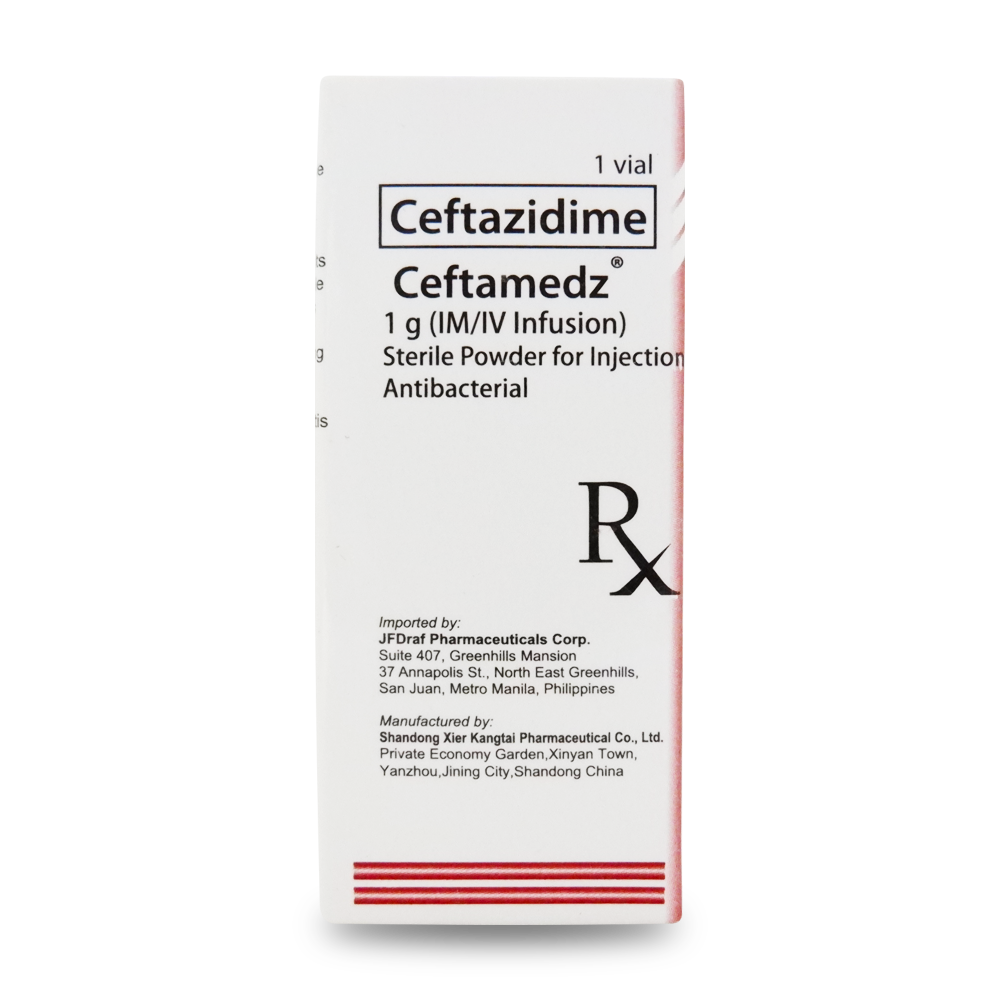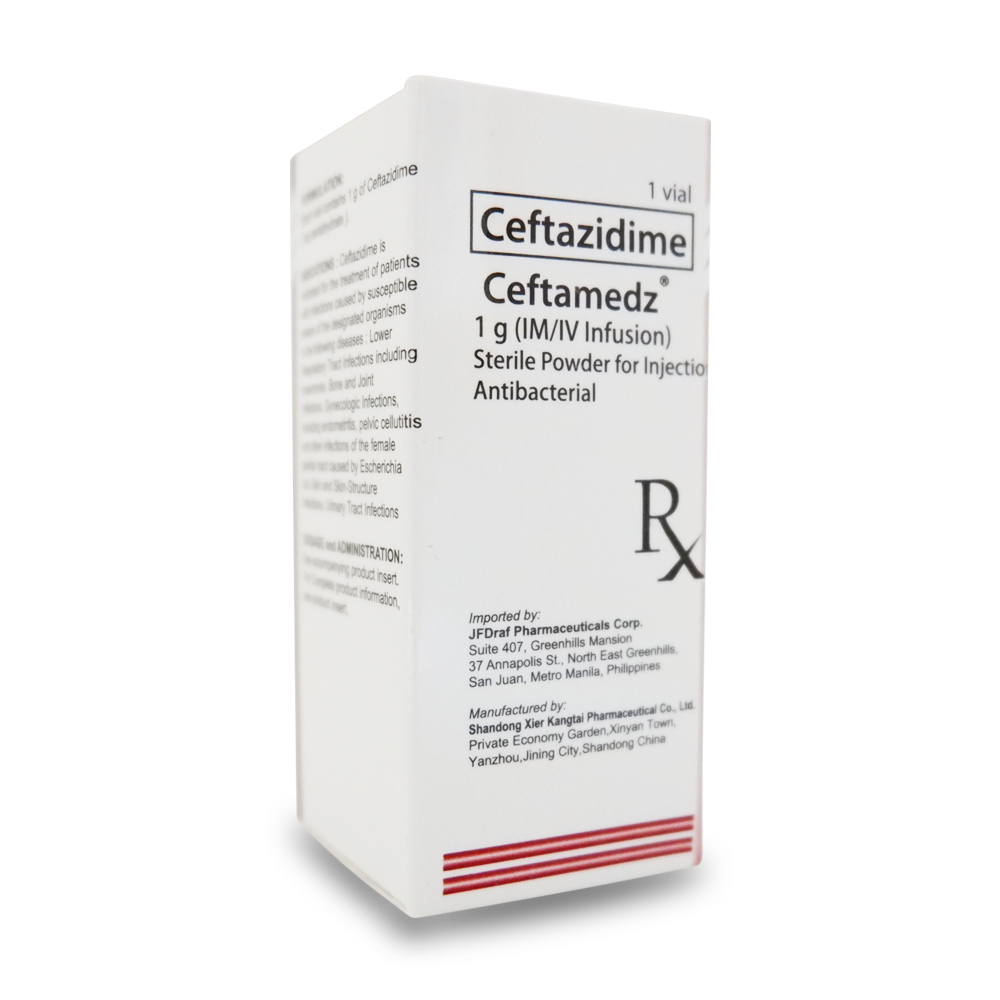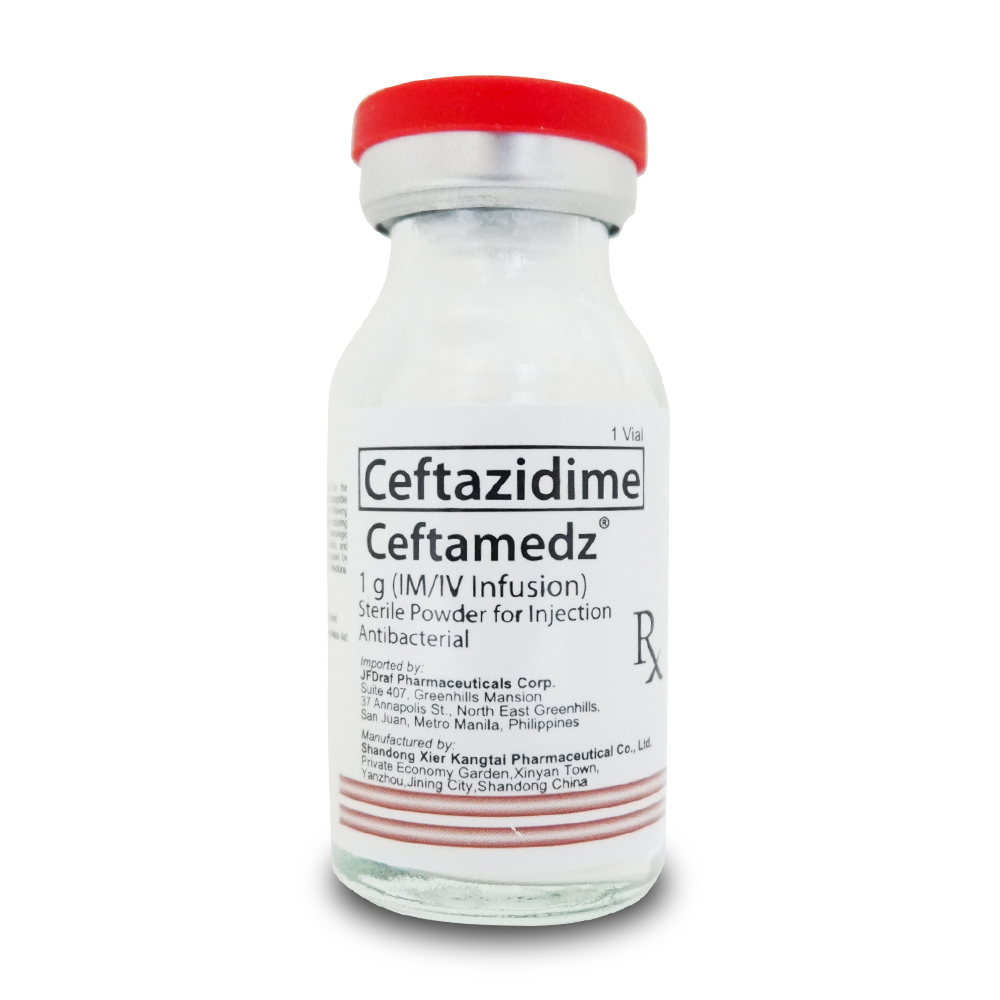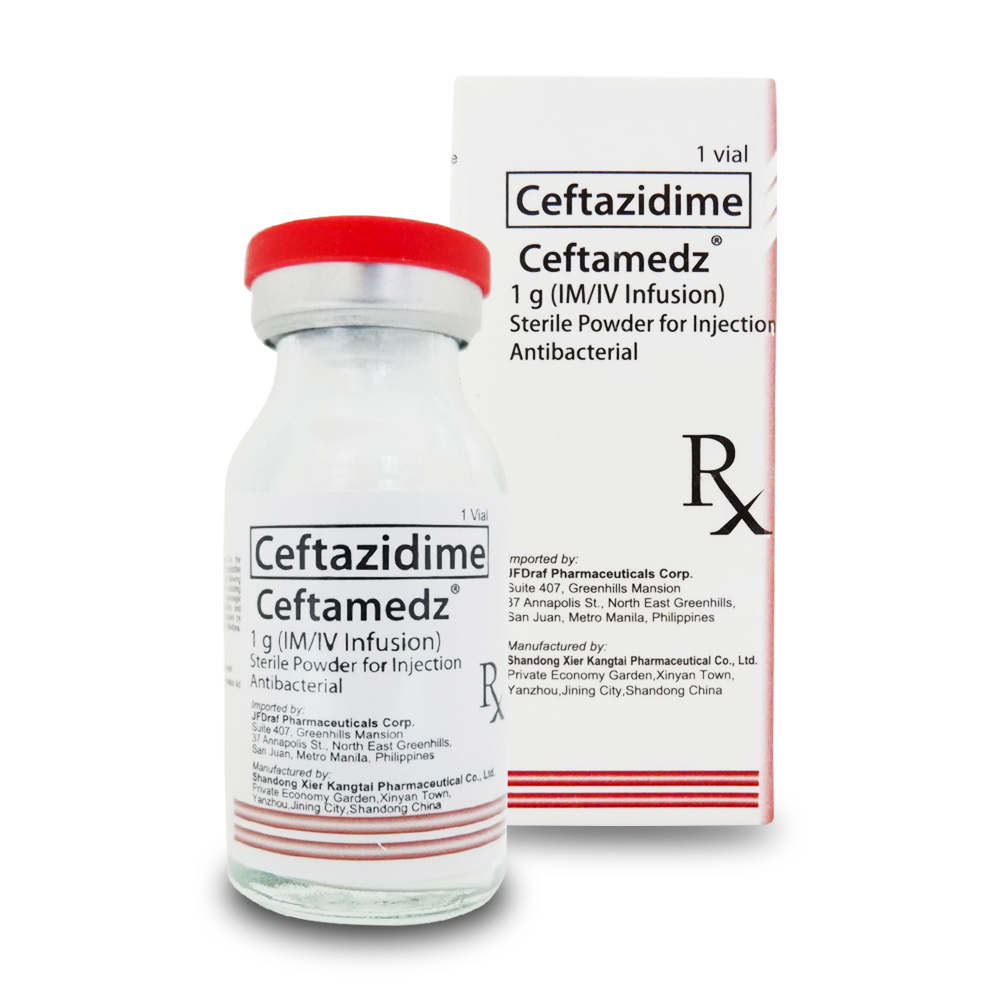



Generic Name: CEFTAZIDIME
Ceftamedz™
1 g (IM/IV Infusion) Sterile Powder for Injection
ANTIBACTERIAL
Formulation:
Each vial contains 1g of ceftazidime (as pentahydrate).
Product Description:
A white or almost white crystaline powder.
Indications:
Ceftazidime is indicated for the treatment of patients with infections caused by susceptible strains of the designated organisms in the following diseases:
1.Lower Respiratory Tract Infections including pneumonia, caused by Pseudomonas aeruginosa and other Pseudomonas spp.; Haemophilus infuenzae, including ampicillin-resistant strains.
2.Bone and Joint Infections, both complicated and uncomplicated, caused by Pseudomonas aeruginosa
3.Gynecologic Infections, including endometritis, pelvic cellutitis, and other infections of the female genital tract caused by Escherichia coli.
4.Skin and Skin-Structure Infections
5.Urinary Tract Infections
It may also be used concomitantly with other antibiotics, such as vanocomycin, aminoglycosides and clindamycin; in severe and life-threatening infections; and in the immunocompromised patient. When such concomitant treatment is appropriate, prescribing information in the labeling for the other antibiotics should be followed. Thhe dose depends on the severity of the infection and the patient’s condition.
Pharmacokinetics:
Absorption
After intramuscular administration of 500mg and 1g ceftazidime, peak plasma level of 18 and 37 mg/mL, respectively are achieved rapidly. Five minutes after intravenous bolus injection of 500mg, 1g or 2g, plasma levels are 46,87 and 170 mg/l, respectively. The kinetics of ceftazidime are linear within the single dose range of 0.5 to 2g following intravenous or intramuscular dosing.
Distribution:
The serum protein binding of ceftazidime is low at about 10%. Concentration in excess of the MIC for common pathogens can be achieved in tissues such as bone, heart, bile, sputum, aqueous humour, synovial, pleural and peritoneal fluids. Ceftazifime crosses the placenta readily and is excreted in the breast milk. Penetration of the intact blood-brain barrier is poor, resulting in low levels of ceftazidime in the CSF in the absence of Inflammation. However concentration of 4 to 20 mg/L or more are achieved in the CSF when the meninges are inflamed.
Biotransformation:
Ceftazidime is not metabolised.
Elimination:
After parenteral administration plasma levels decrease with a half-life of about 2h. Ceftazidime is excreted unchanged into the urine by glomerular filtration; aproximately 80 to 90% of the dose is recovered in the urine within 24 h. Less than 1% is excreted via the bile.
Special Patient Populations:
Renal impairment
Elimination of ceftazidime is decreased in patients with impaired renal function and the dose should be reduced.
Hepatic impairment
The presence of mild to moderate hepatic dysfunction had no effect on the pharmacokinetics of ceftazidime in individual administered 2g intravenously every 8 hours for 5 days, provided renal function was not impaired.
Elderly
The reduced clearance observed in elderly patients was primarily due to age-related decrease in renal clearance of ceftazidime. The mean elimination half-life ranged from 3.5 to 4 hours following single or 7 days repeat BID dosing of 2 g IV bolus injections in elderly patients 80 years or older.
Peadiatric Population
The half-life of ceftazidime is prolonged in preterm and term neonates by 4.5 to 7 hours after doses of 25 to 30 mg/kg. However, by the age of 2 months the half-life is within the range for adults.
Pharmacodynamics:
Pharmacotherapeutic group: Antibacterial for system use. Third-generation cephalosporins ATC code. J01DD02.
Mechanism of action
Ceftazidime inhibits bacterial cell wall synthesis following attachment to penicillin binding proteins (PBPs). This results in the interruption of cell wall (peptidoglycan) biosynthesis, which leads to bacterial cell lysis and death.
PK/PD relationship
For cephalosporins, the most pharmacokinetics-pharmacodynamics index correlating with in vivo efficacy has been shown to be the percentage of the dosing interval that the unbound concentration remains above the minimum inhibitory concentration (MIC) of ceftazidime for individual target species (i.e. % T>MIC).
Mechanism of Resistance
Bacterial resistance to ceftazidime may be due to one or more of the following mechanism:
hydrolysis by beta-lactamases. Ceftazidime may be efficiently hydrolysed by extended-spectrum beta-lactamases (ESBLs), including the SHV family of ESBLs, and AmpC enzymes that may be induced or stably derepressed in certain aerobic Gram-negative bacterial species.
Outer membrane impermeability, which restricts access of ceftazidime to penicillin binding proteins in Gram-negative organism
bacterial efflux pumps.
Microbiological Susceptibility
The prevalence of acquired resistance may vary geographically and with time for selected species and local information on resistance is desirable, particularly when treating severe infections. As necessary, expert advice should be sought when the local prevalence of resistance is such that the utility of ceftazidime in at least some types of infections is questionable.
Commonly Susceptible Species
Gram-positive aerobes:
Streptococcus pyogenes; Streptococcus agalactiae
Gram-negative aerobes:
Citrobacter koseri:Escherichia coli; Haemophilus influenzae; Moraxella catarrhalis; Neisseria meningitidis; Proteus mirabilis; Proteus spp. (other); Providencia spp.
Species for which acquired resistance may be a problem
Gram-positive aerobes:
Acinetobacter baumannii£ +; Burkholderia cepacia; Citrobacter freundii; Enterobacter aerogenes; Enterobacter cloacae Klebsiella pneumoniae; Klebsiella spp, (other); Pseudomonas
Contraindications:
Contraindicated in patients who have shown hypersensitivity to ceftazidime or the cephalosporin group of antibiotics.
Warning:
Before therapy with Ceftazidime is instituted, careful inquiry should be made to determine whether the patient has had previous hypersensitivity reactions to cephalosporins, penicillins, or other drugs. Serious acute hypersensitivity reactions may require treatment with epinephrine and other emergency measures, including oxygen, IV fluids, IV antihistamines, corticosteroids, airway management, as clinically indicated.
Adverse Effects:
Ceftazidime is generally well tolerated. The most common were local reactions following IV injection and allergic and gastrointestinal reactions. May experience rash, at the infection site following IM administration and thrombophlebitis following IV injection of cephalosporins. Other adverse reactions were encountered infrequently.
Hypersensitivity reactions: pruritus, rash and fever. Toxic epidermal necrolysis, Stevens-Jonson syndrome, and erythema multiforme have also been reported.
Gastrointestinal reactions: diarrhea, nausea, vomiting and abdominal pain
Central Nervous System reactions: headache, dizziness.
Hematologic: rare cases of hemolytic anemia have been reported.
Renal and Genitourinary: Renal impairment.
Precautions:
General: High and prolonged serum ceftazidime concentrations can occur from usual dosages in patients with transient or persistent reduction of urinary output because of renal insufficiency.
It should be prescribed with caution in individuals with a history of gastrointestinal diseases, particularly colitis.
Use in Pregnancy and Lactation:
There is no evidence of teratogenic effects, however, this drug should be used during pregnancy only if clearly needed.
Ceftazidime is excreted in human milk in low concentrations. Caution should be exercise when it is administered.
Overdose:
Ceftazidime over dosage has occurred in patients with renal failure. Reactions included seizure activity, encephalopathy, neuromuscular excitability, and coma. Patients who receive an acute over dosage should be carefully observed and given supportive treatment. In the presence of renal insufficiency, hemodialysis or peritoneal dialysis may aid in the removal of ceftazidime from the body.
Direction for Reconstitution:
Size Amount of diluent to be added (mL) Approximate available volume (mL) Approximate ceftazidime
concentration (mg/mL)
Intramuscular
1-gram vial Intravenous 1-gram vial 3.010.010.0 3.610.8100 28010010
infusion pack 1-gram vial
Dosage and Administration:
Ceftazidime is available as the pentahydrate but it is formulated with sodium carbonate, to form the sodium salt in solution. It is administered by deep intramuscular injection, slow intravenous injection over 3 to 5 minutes, or intravenous infusion over up to 30 minutes.
Adults: The usual dose for adults ranges from 1 to 6g daily in divided doses every 8 or 12 hours. The higher doses are used in severe infections especially in immunocompromised patients. In adults with cystic fibrosis who have pseudomonal lung infections, high doses of 100 to 150 mg per kg body-weight daily in 3 divided doses are used; up to 9g daily has been given to adults with normal renal function.
Single doses of more than 1g should be given intravenously.
Children: Are usually given 30 to 100mg per kg daily in 2 or 3 divided doses, but in severely ill children up to 150mg per kg daily to a maximum of 6g daily may be given in 3 divided doses.
Neonates and infants up to 2 months old : have been given 25 to 60 mg per kg daily in 2 divided doses.
In elderly the dose should generally not exceed 3g daily.
In patients with impaired renal function the dosage may need to be reduced. Following a loading dose of 1g, maintenance doses are based on the creatinine clearance. Suggested maintenance doses are: creatinine clearance 31 to 50mL per minute, 1g every 12 hours; creatinine clearance 16 to 30mL per minute, 1g every 24 hours; creatinine clearance 6 to 15mL per minute, 0.5g every 24 hours; creatinine clearance less than 5mL per minute, 0.5g every 48 hours. In severe infections these doses may need to be increased by 50%. In these patients ceftazidime through serum concentrations should not exceed 40µg per mL. In patients undergoing peritoneal dialysis a loading dose of 1g may be given followed by 500mg every 24 hours; ceftazidime sodium may also be added to the dialysis fluid, usually 125 to 250mg of ceftazidime for 2 litres dialysis fluid. In patients on haemodialysis the appropriate maintenance dose of ceftazidime should be repeated after each dialysis period.
For surgical infection prophylaxis in patients undergoing prostatic surgery, a dose of 1g may be given at induction of anaesthesia and repeated if necessary when the catheter is removed.
Caution:
Foods, Drugs, Devices and Cosmetics Act prohibits dispensing without prescription.
Availability:
Ceftamedz 1g vial per box.
Store at Temperatures not Exceeding 25°C.
Protect from Light.
For suspected adverse drug reaction report to the FDA: www.fda.gov.ph
location_on Lagazo Village, Calinan, Davao City
local_phone (082) 299 1768
phone_android +63 917 301 4186